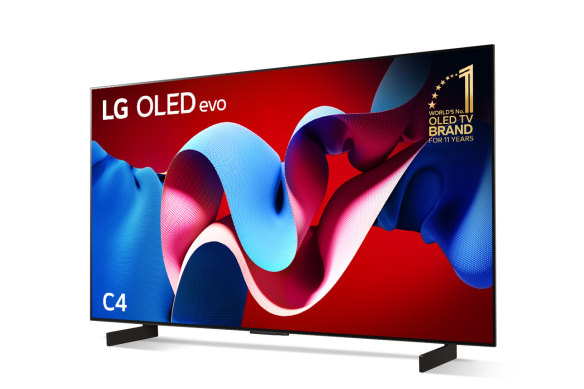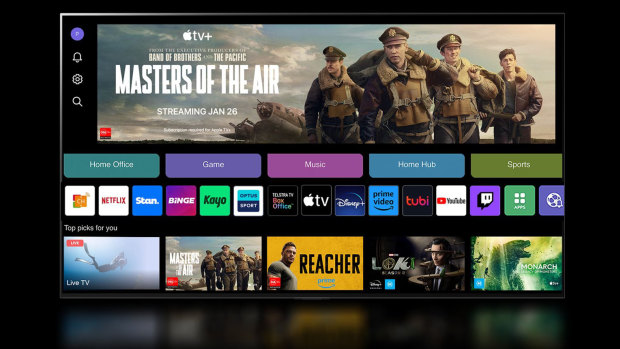- Review
- Technology
- Home tech
This was published 3 months ago
This new LG TV puts many pricier models to shame
By Tim Biggs
Over the past five years, LG’s C-series has upended the way TVs are made and marketed – for the better. Rather than keep all the best features exclusive to the most expensive models, these are priced in the premium mid-range but pack a combination of features and performance that make them extremely close to the best on the market at any price.
This year’s C4 keeps the tradition going with an incredibly bright panel and no clear weak spots. At $2200 for the smallest 42-inch model, $4300 for the big 65-inch and $8000 for the huge 83-inch, these are still expensive TVs. But whether you’re streaming Dolby Vision TV shows, watching classic Blu-ray movies with lossless DTS soundtracks, or gaming at 144 frames per second, the C4 puts many pricier TVs to shame with its breadth and performance.
The year-on-year upgrade is minimal; if you have last year’s C3, there’s of course no way you’re going to want to move up.
But on the other hand, the new TV is brighter than last year’s — noticeably so when watching HDR-enabled content — and has just enough feature additions that it’s probably worth considering over a C3 model that’s been put on sale.
Picture perfect
Brightness and colour is phenomenal out of the box, and there’s very little need for any calibration. A lot of processing options are on by default to make sure whatever you’re watching looks clean, but if you prefer things to look accurate, a pair of expert settings (one for bright rooms and one for dark) cuts out most of the TV’s meddling so movies and TV shows look how they should.

The 42-inch C4 is the best small-screen OLED you can get, and it has all the features of its larger siblings.
Filmmaker mode takes things a step further by prioritising accuracy above all else, meaning you can’t really tweak it at all. It really only works in a pitch-black space because the picture is no longer boosted to combat glare and reflections, but new this year is the ability for filmmakers to use Dolby Vision, so you still get striking highlights out of films and TV designed for HDR.
Of course, if you’re not watching new Hollywood movies and TV shows, accuracy isn’t always the best choice, and the C4’s processing excels here with its incredible handling of low-resolution content and less-than-optimal streams. I’ve always been staunchly against motion interpolation (where the TV invents extra frames to smooth out choppy video), and generally turn it off for good the second I set up any TV. But for certain content like old DVDs, I find LG’s “cinematic movement” preset has an incredibly light touch and does just enough to stop the awkward juddering.
The TV is also plenty smart enough to take care of everything itself if you don’t want to tinker at all. Turning on the AI sound and video functions results in a generally fantastic experience if you want to make the most of everything your screen and audio system can do. Allowing “auto filmmaker” will activate that super-accurate mode only when it makes sense to do so. And playing a video game automatically switches on an optimiser that provides a brilliantly immediate low-latency experience.
Software-wise LG’s WebOS is smooth and seamless, and I appreciate that a lot of the stuff I generally consider to be annoying bloat (random streaming channels, cross-platform recommendations) are hidden in places you have to go intentionally, rather than getting in the way on the home screen. The app store had almost every streaming app I could think of; Kanopy and Shudder were the only ones missing.

The WebOS home screen does have ads, but it’s a lot less cluttered than most new smart TVs.
All bases covered
One of the best things about this TV is that it covers every single format and feature you could hope for. It’s always disappointing to plug something into a TV and find out that it doesn’t work as well as it should, but it’s tough to imagine that happening on the C4.
This TV supports Dolby Vision, HDR10 and HLG HDR formats, and there’s not a video resolution and refresh rate combo I could find that it didn’t handle perfectly. It will process both DTS and Dolby surround formats over HDMI ARC or optical, which you’ll want if you have a varied collection of movies on disc. If you have a newer audio system that uses eARC, it will also happily pass through the full range of Dolby and DTS spatial formats, including Atmos and DTS X, or bitstream up to 7.1 channels so your receiver can work it out.
It also supports both AirPlay 2 and Chromecast for flinging video from other devices, has 5Ghz Wi-Fi plus an Ethernet port, and will pass through 4:4:4 video which is only needed if you’re connecting a PC or some kind of video reference equipment.
For games, all four HDMI 2.1 ports support the full 48Gbps bandwidth, so you don’t have to miss out on any features. Gaming at up to 4K 144Hz works great if your hardware supports it, every single feature of the PlayStation 5 and Xbox Series X is covered, and variable refresh rates of every format (G-Sync, Freesync, HDMI Forum) are available to keep things as smooth as possible.
Of course, very few people are going to need all of these bells and whistles. But plenty of people are going to have one particular situation where they need the TV to do something esoteric (like pass through a surround format that isn’t commonly used from a device to the soundbar), and it’s good to know these are covered.
One potential exception is that the C4 does not support HDR10+, a free alternative to Dolby Vision created by a consortium of movie studios and Samsung. This isn’t a huge deal because in my experience movies with HDR10+ also support Dolby Vision. But it would be nice to see it included here as an option, if only to account for a potential future where some Blu-Ray supports HDR10+ only. After all, LG has accounted for pretty much every other edge case.
Get news and reviews on technology, gadgets and gaming in our Technology newsletter every Friday. Sign up here.